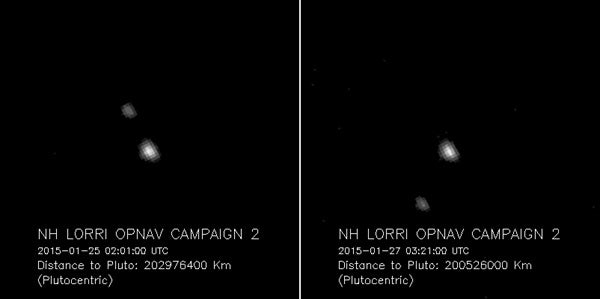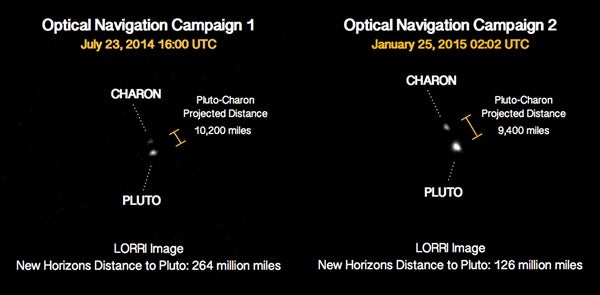Tombaugh, who died in 1997, was born February 4, 1906.
“This is our birthday tribute to Professor Tombaugh and the Tombaugh family, in honor of his discovery and life achievements, which truly became a harbinger of 21st-century planetary astronomy,” said New Horizons Principal Investigator Alan Stern, from the Southwest Research Institute, Boulder, Colorado. “These images of Pluto, clearly brighter and closer than those New Horizons took last July from twice as far away, represent our first steps at turning the pinpoint of light Clyde saw in the telescopes at Lowell Observatory 85 years ago into a planet before the eyes of the world this summer.”
The new images, taken with New Horizons’ telescopic Long-Range Reconnaissance Imager (LORRI) on January 25 and January 27, were the first acquired during the spacecraft’s 2015 approach to the Pluto system, which culminates with a close flyby of Pluto and its system of moons on July 14. New Horizons was more than 126 million miles (203 million kilometers) away from Pluto when it began taking the photos, which show Pluto and its largest moon, Charon.
“Pluto is finally becoming more than just a pinpoint of light,” said Hal Weaver, New Horizons project scientist at the Johns Hopkins University Applied Physics Laboratory (APL) in Laurel, Maryland. “LORRI has now resolved Pluto, and the dwarf planet will continue to grow larger and larger in the images as New Horizons spacecraft hurtles toward its targets. The new LORRI images also demonstrate that the camera’s performance is unchanged since it was launched more than nine years ago.”
Over the next few months, LORRI will take hundreds of pictures of Pluto against star fields to refine the team’s estimates of New Horizons’ distance to Pluto. As in these first images, the Pluto system will resemble little more than bright dots in the camera’s view until late spring, but mission navigators will use these images to design course-correcting engine maneuvers that precisely aim New Horizons on approach. The first such maneuver based on these “optical navigation” images, or “OpNavs,” is scheduled for March 10.
Closing in on Pluto at about 31,000 mph (50,000 km/h), New Horizons has already covered more than 3 billion miles (5 billion km) since launch January 19, 2006. Its epic journey has taken it past each planet’s orbit from Mars to Neptune in record time, and it is now in the first stage of an encounter with Pluto that includes long-distance imaging as well as dust, energetic particle, and solar wind measurements to characterize the space environment near Pluto.











